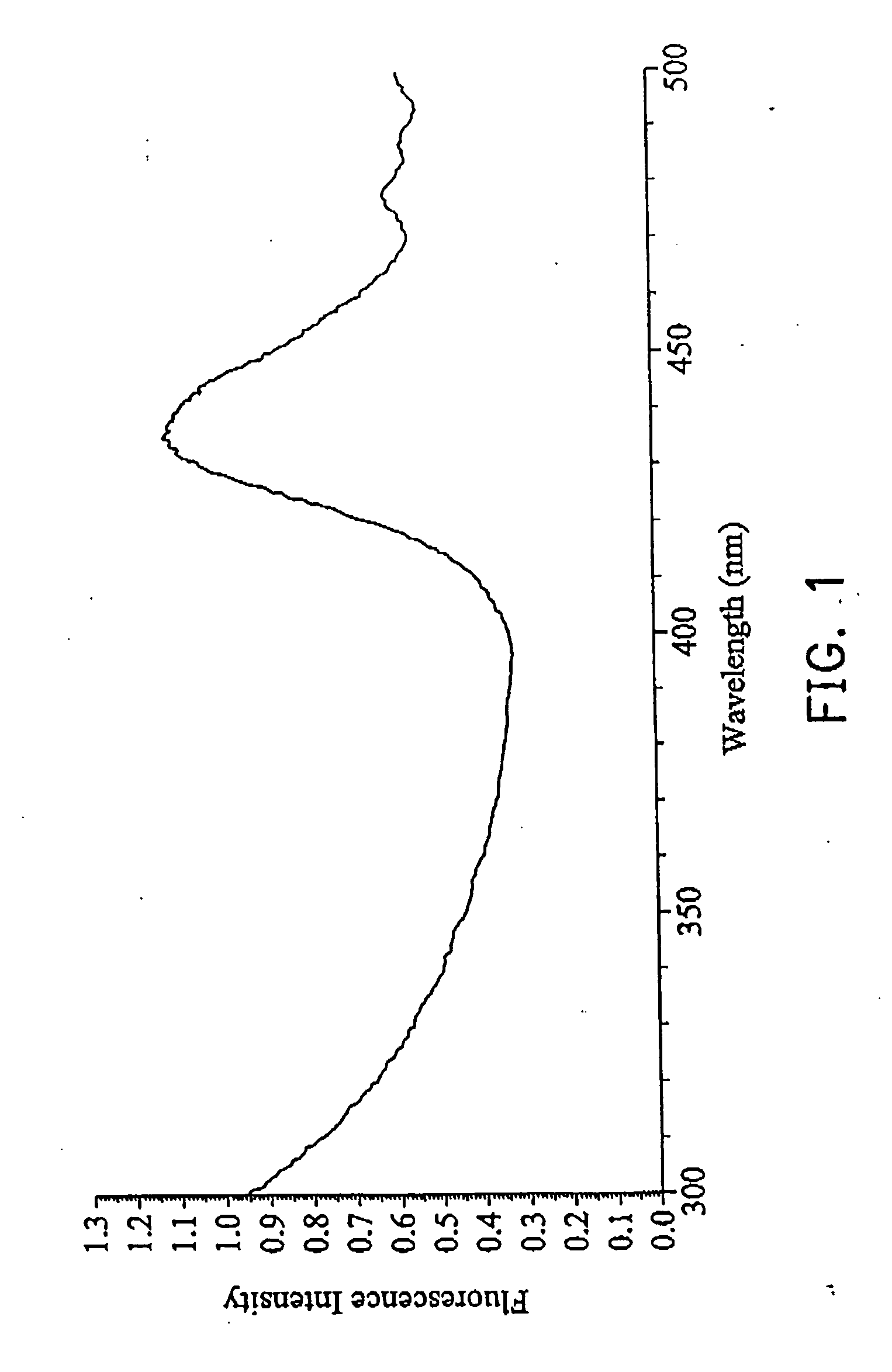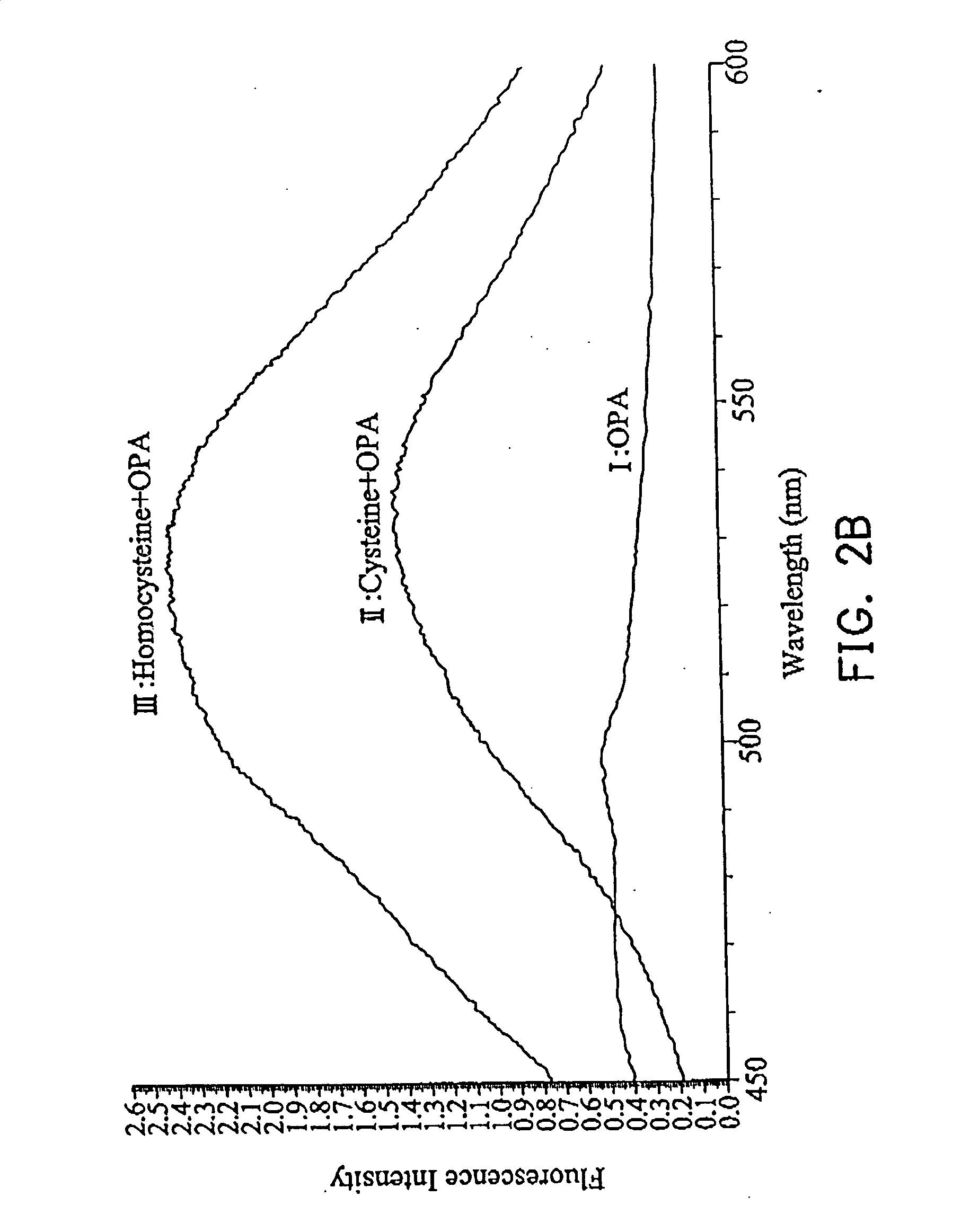Assay and kit for homocysteine
a technology of homocysteine and kit, which is applied in the field of chemical assays, can solve the problems of elevated levels of homocysteine in the blood of people, increased risk of heart attack or stroke, increased risk of heart and vessel disease, etc., and achieves the effect of rapid detection of homocystein
- Summary
- Abstract
- Description
- Claims
- Application Information
AI Technical Summary
Benefits of technology
Problems solved by technology
Method used
Image
Examples
example 1
[0032] 1 ml Tris-(hydroxymethyl)aminomethane (TRIS) buffer (100 mM), containing 1 mM ethylenediamine tetraacetic acid (EDTA) and 18 mM sodium borohydride (NaBH4) were added to 1 ml solution containing homocysteine, cysteine, and water respectively, stirring for 2 minutes at room temperature. The mixtures were combined with 0.018 mM o-phthalaldehyde (OPA) in 20% aqueous methanol to form fluorescent complex. The emission spectra were detected with 525 nm to monitor the absorption from 300 to 500 nm, as shown in FIG. 1. The fluorescent adduct was monitored with 450˜600 nm (λmax=524 nm) using excitation with 436 nm light. The fluorescence of homocysteine adduct was enhanced after standing 4 min and the fluorescence of cysteine adduct disappeared after standing 4 min, so cysteine and homocysteine in a bio-sample can be separated by way of different spectrometric characteristics, as shown in FIG. 2A.
[0033]FIG. 2A shows fluorescent spectra of three samples from wavelength 450˜600 nm at th...
example ii
[0041] This embodiment of the present invention shows the preferred detection time of the homocysteine assay. 100 mM TRIS buffer containing 1 mM EDTA and 18 mM NaBH4 was added to samples containing homocysteine with equivalent volume to react for 2 minutes. The above mixtures were then added to 18 mM o-phthalaldehyde in 20% ethanol solution. The samples were detected after 1, 5, 10, 20, 30 and 50 minutes respectively using exciting with 436 nm light and detecting with 450˜600 nm. The results are shown in FIG. 3A. In FIG. 3A, the fluorescence of homocysteine-OPA complex rises from 1 minute and achieves the strongest emission at the fifth minute. The fluorescence then decays as the reaction time extends to the fiftieth minute. Further, samples containing homocysteine were added to 100 mM TRIS buffer containing 1 mM EDTA and 100 mM NaBH4 to react for 2 minutes. The above mixtures were then added to 100 mM o-phthalaldehyde in 20% ethanol solution and the fluorescence were detected at 1,...
example iii
[0043] A preferred kit and method for homocysteine assay according to one embodiment of the invention is disclosed.
[0044] The homocysteine assay includes in this embodiment a competing agent with an amino group (—NH2). The preferred competing agent is an amine, acetamide, ethylamine or tris-(hydroxymethyl)aminomethane (TRIS). Preferably, the competing agent is 100 mM TRIS buffer containing ethylenediamine tetraacetic acid (EDTA) and sodium borohydride. The kit also comprises a reactive agent that reacts with the amino groups of cysteine, homocysteine and the competing agent. In a preferred embodiment, the reactive agent is an aldehyde, such as 1-100 mM o-phthalaldehyde (OPA) in 20% ethanol or methanol solution. The reactivity of the competing agent and the reactive agent should be higher than cysteine and the reactive agent but lower than homocysteine and the reactive agent. The reactive agent only forms fluorescent compound with homocysteine but not with the competing agent.
[0045...
PUM
 Login to View More
Login to View More Abstract
Description
Claims
Application Information
 Login to View More
Login to View More - R&D
- Intellectual Property
- Life Sciences
- Materials
- Tech Scout
- Unparalleled Data Quality
- Higher Quality Content
- 60% Fewer Hallucinations
Browse by: Latest US Patents, China's latest patents, Technical Efficacy Thesaurus, Application Domain, Technology Topic, Popular Technical Reports.
© 2025 PatSnap. All rights reserved.Legal|Privacy policy|Modern Slavery Act Transparency Statement|Sitemap|About US| Contact US: help@patsnap.com



